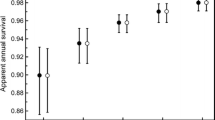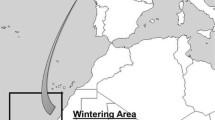Abstract
The trade-off between current and future reproduction plays an important role in demographic analyses. This can be revealed by the relationship between the number of years without reproduction and reproductive investment within a reproductive year. However, estimating both the duration between two successive breeding season and reproductive effort is often limited by variable recapture or resighting effort. Moreover, a supplementary difficulty is raised when nonbreeder individuals are not present sampling breeding grounds, and are therefore unobservable. We used capture–recapture (CR) models to investigate intermittent breeding and reproductive effort to test a putative physiological trade-off in a long-lived species with intermittent breeding, the leatherback sea turtle. We used CR data collected on breeding females on Awa:la-Ya:lima:po beach (French Guiana, South America) from 1995 to 2002. By adding specific constraints in multistate (MS) CR models incorporating several nonobservable states, we modelled the breeding cycle in leatherbacks and then estimated the reproductive effort according to the number of years elapsed since the last nesting season. Using this MS CR framework, the mean survival rate was estimated to 0.91 and the average resighting probability to 0.58 (ranged from 0.30 to 0.99). The breeding cycle was found to be limited to 3 years. These results therefore suggested that animals whose observed breeding intervals are greater than 3 years were most likely animals that escaped detection during their previous nesting season(s). CR data collected in 2001 and 2002 allowed us to compare the individual reproductive effort between females that skipped one breeding season and females that skipped two breeding seasons. These inferences led us to conclude that a trade-off between current and future reproduction exists in leatherbacks nesting in French Guiana, likely linked to the resource provisioning required to invest in reproduction.




Similar content being viewed by others
References
Akaike H (1974) A new look at the statistical model identification. IEEE Trans Automatic Control 19:716–723
Anderson DR, Burnham KP, White GC (1994) AIC model selection in overdispersed capture–recapture data. Ecology 75:1780–1793
Bonnet X, Naulleau G, Shine R, Lourdais O (2001) Short-term versus long-term effects of food intake on reproductive output in viviparous snake (Vipera aspis). Oikos 92:297–308
Brownie C, Hines JE, Nichols JD, Pollock KH, Hestbeck JB (1993) Capture–recapture studies for multistrata including non-markovian transitions. Biometrics 49:1173–1187
Bull JJ, Shine R (1979) Iteroparous animals that skip opportunities for reproduction. Am Nat 114:296–303
Burnham KP, Anderson DR (1998) Model selection and inference: a practical information-theoretic approach. Springer, Berlin Heidelberg New York
Burnham KP, Anderson DR, White GC, Brownie C, Pollock KH (1987) Design and analysis methods for fish survival experiments based on release-recapture. Am Fish Soc Monogr 5:1–437
Cam E, Hines JE, Monnat JY, Nichols JD, Danchin E (1998) Are adult nonbreeders prudent parents? The kittiwake model. Ecology 79:2917–2930
Cam E, Oro D, Pradel R, Jiménez J (2004) Assessment of hypotheses about dispersal in a long-lived seabird using multistate capture–recapture models. J Anim Ecol 73:723–736
Carr AF, Carr MH (1970) Modulated reproductive periodicity in Chelonia mydas. Ecology 51:335–337
Chevalier J, Cazelles B, Girondot M (1998) Apports scientfiques à la stratégie de conservation des tortues luths en Guyane française. JATBA Rev Ethnobiol 40:485–507
Choquet R, Reboulet AM, Pradel R, Gimenez O, Lebreton JD (2004) M-SURGE : new software specifically designed for multistate recapture models. Anim Biodivers Conserv 27:207–215
Clutton-Brock TH (1988) Reproductive success. University of Chicago Press, Chicago
Cormack RM (1964) Estimates of survival from the sighting of marked animals. Biometrika 51:429–438
Coulson JC (1984) The population dynamics of Eider Duck Somateria mollissima and evidence of extensive non-breeding by adult ducks. Ibis 126:525–543
Danchin E, Cam E (2002) Non-breeding as a potential cost of breeding dispersal. Behav Ecol Sociobiol 51:153–163
Davenport J (1991) Biology of leatherback turtle Dermochelys coriacea (Vandelli, 1761). BCG Testudo 3:24–33
Drent RH, Daan S (1980) The prudent parent: energetic adjustments in avian breeding. Ardea 68:225–252
Ferraroli S, Eckert S, Chevalier J, Girondot M, Kelle L, Maho YL (2000) Marine behavior of leatherback turtles nesting in French Guiana for conservation strategy. In: Mosier A, Foley A, Brost B (eds) 20th annual symposium on sea turtle biology and conservation. NOAA Technical Memorandum NMFS-SEFSC-477, Orlando, Florida, USA
Ferraroli S, Georges J-Y, Gaspar P, Le Maho Y (2004) Endangered species: where leatherback turtles meet fisheries. Nature 429:521–522
Fretey J, Girondot M (1988) Nidification de la tortue luth sur le littoral de Guyane française pendant la saison 1987. Ann Soc Sci Nat Charente-Maritime 7:729–737
Fujiwara M, Caswel H (2002) Estimating population projection matrices from multi-stage mark-recapture data. Ecology 83:3257–3265
Girondot M, Fretey J (1996) Leatherback turtles, Dermochelys coriacea, nesting in French Guiana, 1978–1995. Chelonian Conserv Biol 2:204–208
Girondot M, Tucker AD, Rivalan P, Godfrey M, Chevalier J (2002) Density-dependent nest destruction and population decline of Guianan leatherback turtles. Anim Conserv 5:75–84
Godley BJ, Broderick AC, Moraghan S (1999) Short-term effectivness of Passive Integrated Transponder (PIT) tags used in the study of Mediterranean marine turtles. Chelonian Conserv Biol 3:477–479
Hughes GR (1982) Nesting cycles in sea turtles—typical or atypical? In: Bjorndal KA (ed) Biology and conservation of sea turtles. Smithsonian institut press, Washington DC, pp 81–89
Husting EL (1965) Survival and breeding structure in a population of Ambystoma maculatum. Copeia:352–362
Jolly GM (1965) Explicit estimates from capture–recapture data with both death and immgration - stochastic model. Biometrika 52:225–247
Kendall WL, Nichols JD (2002) Estimating state-transition probabilities for unobservable states using capture–recapture/resighting data. Ecology 83:3276–3284
Lebreton J-D, Clobert J (1991) Bird population dynamics, management, and conservation: the role of mathematical modelling. In: Perrins CM, Lebreton JD, Hirons GJM (eds) Bird population studies, relevance to conservation and management. Oxford University Press, Oxford, pp 105–125
Lebreton J-D, Pradel R (2002) Multistate recapture models: modelling incomplete individual histories. J Appl Stat 29:353–369
Lebreton J-D, Burnham KP, Clobert J, Anderson DR (1992) Modeling survival and testing biological hypotheses using marked animals: a unified approach with case studies. Ecol Monogr 62:67–188
Lourdais O, Bonnet X, Shines R, Denardo D, Naulleau G, Guillon M (2002) Capital-breeding and reproductive effort in a variable environment: a longitudinal study of viviparous. J Anim Ecol 71:470–479
Miller JD (1996) Reproduction in sea turtles. In: Lutz PL, Musick JA (eds) The biology of sea turtles. CRC Press Inc., Boca Raton Floria, pp 52–71
Naulleau G, Bonnet X (1996) Body condition threshold for breeding in viviparous snake. Oecologica 107:301–306
Nichols JD, Hines JE, Pollock KH, Hinz RL, Link WA (1994) Estimating breeding proportions and testing hypotheses about costs of reproduction with capture–recapture data. Ecology 75:2052–2065
Pollock KH (1982) A capture–recapture design robust to unequal probability of capture. J Wildl Manage 46:752–757
Pradel R (1993) Flexibility in survival analysis from recapture data : handling trap-dependence. In: Lebreton J-D, North PM (eds) Study of bird population. Birkhäuser Verlag, Basel, pp 29–37
Pradel R, Hines JE, Lebreton J-D, Nichols JD (1997) Capture–recapture survival models taking account of transients. Biometrics 53:60–72
Prévot-Julliard A-C, Lebreton J-D, Pradel R (1998) Re-evaluation of the adult survival of Black-headed Gulls (Larus ridibundus) in presence of recapture heterogeneity. The Auk 115:85–95
Reznick D (1985) Cost of reproduction: an evaluation of the empirical evidence. Oikos 44:257–267
Rivalan P, Godfrey MH, Prévot-Julliard A-C, Girondot M (2005) Maximum likelihood estimates of tag loss in leatherback sea turtles. J Wildl Manage 69:540–548
Rostal DC, Grumbles JS, Palmer KS, Lance VA, Spotila JR, Paladino FV (2001) Changes in gonadal and adrenal steroid levels in the leatherback sea turtle (Dermochelys coriacea) during the nesting cycle. Gen Comp Endocrinol 122:139–147
Schaffer WM (1974) Optimal reproductive effort in fluctuating environments. Am Nat 108:783–790
Schaub M, Pradel R (2004) Assessing the relative importance of different sources of mortality from recoveries of marked animals. Ecology 85:930–938
Schaub M, Pradel R, Jenni L, Lebreton J-D (2001) Migrating birds stop over longer than usually thought: an improved capture–recapture analysis. Ecology 82:852–859
Schaub M, Gimenez O, Schmidt BR, Pradel R (2004) Estimating survival and temporay emigration using multistatecapture–recapture framework. Ecology 85:2107–2113
Seber GAF (1965) A note on the multiple-recapture census. Biometrika 52:249–259
Spotila JR, Dunham AE, Leslie AJ, Steyermark AC, Plotkin PT, Paladino FV (1996) Worldwide population decline of Dermochelys coriacea: are leatherback turtles going to extinct? Chelonian Conserv Biol 2:209–222
Stearns SC (1989) Trade-offs in life-history evolution. Funct Ecol 3:259–268
Viallefont A, Cooke F, Lebreton JD (1995) Age-specific cost of first-time breeding. The Auk 112:67–76
Weimerskirch H (1998) How can a pelagic seabird provision its chick when relying on a distant resource? Cyclic attendance, foraging decision and body condition in sooty shearwaters. J Anim Ecol 67:99–109
Williams GC (1966) Natural selection,the cost of reproduction and a rafinement of Lack’s principle. Am Nat 100:687–690
Wooller RD, Bradley JS, Skira IJ, Serventy DL (1990) The late reproductive success of Short-tailed Shearwaters Puffinus tenuirostris in relation to their age and breeding experience. J Anim Ecol 59:161–170
Zar JH (1999) Biostatistical analysis. Prentice Hall, Upper Saddle River
Zug GR, Parham JF (1996) Age and growth in leatherback turtles, Dermochelys coriacea (Testudines: Dermochelyidae): a skeletochronological analysis. Chelonian Conserv Biol 2:244–249
Acknowledgments
For data used in this study, we are indebted to everyone that has participated in the Kawana project in French Guiana and especially to J. Fretey and J. Lescure, who were in charge of this project from 1977 to 1996. We also thank the authorities and inhabitants of Awa:la and Ya:lima:po villages for their active participation in the marine turtle study and conservation program. The tag database used for this study is the result of a joint effort of the organizations involved in sea turtles conservation in French Guiana (Direction Régionale de l’Environnement, Greenpeace, Kulalashi, Kwata, ONCFS, Sépanguy, WWF) and in Suriname (Biotopic, STINASU, WWF). Finally, we thank E. Baudry, D. Drolet, J.-S. Lauzon-Guay, M. Godfrey, T. Giraud, E. Johannesen, R. Julliard, and J. Shykoff for their comments on the manuscript.
Author information
Authors and Affiliations
Corresponding author
Additional information
Communicated by Roland Brandl
Rights and permissions
About this article
Cite this article
Rivalan, P., Prévot-Julliard, AC., Choquet, R. et al. Trade-off between current reproductive effort and delay to next reproduction in the leatherback sea turtle. Oecologia 145, 564–574 (2005). https://doi.org/10.1007/s00442-005-0159-4
Received:
Accepted:
Published:
Issue Date:
DOI: https://doi.org/10.1007/s00442-005-0159-4




